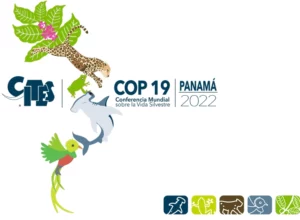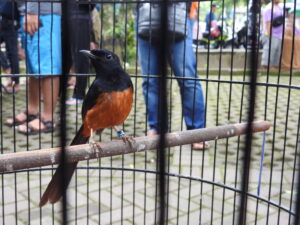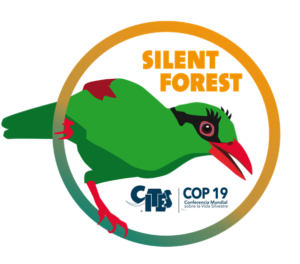Many are aware of the approaching environmental conferences, particularly the UN Climate CoP27 and perhaps at least heard of the CBD UN Biodiversity CoP15 to be held in December, but only few will know the CITES CoP19; a crucial meeting for wildlife conservation that will take place fron 14 to 25 November 2022 in Panama City, Panama.
CITES stands for the Convention on International Trade in Endangered Species of Wild Fauna and Flora. It is a global policy framework to fight the extinction crisis through the regulation of international wildlife trade. The intergovernmental policy convention seeks to ensure the sustainable use of wildlife and the conservation of wild species which are threatened by trade.
CITES protects around around 38,700 species, including roughly 5,950 animals and 32,800 plants. Protected species are listed in one of three Appendices (I, II or III), with Appendix I having the strictest regulations. 
CITES has 184 signatory countries, called Parties. Every two to three years these Parties collectively meet to review the progress of species conservation, amend CITES regulations and review the challenges and successes of implementing the Convention. These so-called Conferences of the Parties (CoP) covers a wide range of topics, from general policy to more specific species issues.
The Silent Forest Group will be joining the CoP19 in 2022 as part of the EAZA delegation in the role as an Observer NGO. We strongly support the better use of CITES for increased protection of songbirds and during the event we will be actively advocating for this.
At each CITES CoP, Parties can propose adding species to be listed in, removed from or shifted between the CITES Appendices to ensure there is sustainable trade. Each of the 184 Parties reviews these proposals and decides if they support or oppose them. At this year’s CoP19 there are 52 proposals to be decided upon in a majority vote election.
At CoP19 there are two proposals concerning songbirds both of which are firmly supported by the Silent Forest Group:
- Proposal 8, submitted by the governments of Malaysia and Singapore to list the White-rumped Shama (Kittacincla malabarica) in Appendix II.
- Proposal 9, submitted by the governments of Singapore, Malaysia and USA to up-list the Straw-headed Bulbul (Pycnonotus zeylanicus) from Appendix II to Appendix I.

In addition to the species proposals at the CITES CoP, discussions also take place to review strategic matters (such as reports from the specialist committees or a review of CITES work, interpretation and implementation matters, significant trade reviews or reports on wildlife crime and illegal trade and species-specific matters.
At the CoP19 side events are important avenues to advocate policy.
The Silent Forest Group will co-host a side event together with many partners including: (in alphabetical order): Association of Zoos and Aquariums (AZA), Birdlife International, European Association of Zoos and Aquaria (EAZA), IUCN SSC Asian Songbird Trade Specialist Group (ASTSG), Monitor Conservation Research Society (Monitor), Red Siskin Initiative, Species360, TRAFFIC, United States Fish & Wildlife Service, Wildlife Conservation Society (WCS), World Association of Zoos and Aquaria (WAZA)
The title of the side event will be “Silent Forest – Songbird Trade”. It will take place on 23 November from 7-9 pm in the Panama Convention Center

The aim of our joint side event is to share information with CITES Parties and Observer organizations on matters of songbird trade and to create an opportunity to meet and discuss songbird trade-research and conservation with a focus on:
- Presenting current songbird trade research as well as new information resources, including two major reviews mentioned in CoP19 Doc. 74 that can be used for the CITES decision making process.
- Advocating for stronger use of CITES as a tool to protect threatened species of songbirds from unsustainable and illegal international trade and enable data collection and access for stronger evidence-based decisions in the future (links to CoP19 Doc74 – Songbird trade and conservation management)
- Supporting the two listing proposals for songbirds (White-rumped Shama and Straw-headed Bulbul) after the fact using them as examples for other species.
- Presenting about holistic conservation approaches and challenges of a songbird species already protected by CITES (Red Siskin Initiative).
Overall, our key message is “songbirds need better protection under CITES”
Nearly all species of birds of prey, falcons, owls and parrots are listed in CITES. However, our data show that more species of songbirds are traded internationally than all these other groups put together. Yet only 1.4% of the songbirds species are CITES listed.
Several species of Songbirds are threatened by trade, particularly domestically, still international trade helps drive and worsen this issue. Using the precautionary principle for Appendix II listings allows data collection and influence national legislation and protected species lists.
A CITES listing means access to real quantifiable trade data which will enable the assessment of the sustainability of international trade the analysis of regional trade patterns. This is especially imortant for species whose survival are known to be threatened by trade and for which there is also evidence of international trade.
The large number of songbird species is challenging and some species are similar looking which may result in misidentification by the authorities or organizations tasked with their protection or cause data gaps.
Resources developed by NGO’s and a network of species experts can help identify priorities and solve species identification challenges. These resources are available for authorities.
Our call for better protection of songbirds is linked to the CBD 2030 targets, the State of the Worlds Birds Report 2022, the IUCN Motion 120 on Action Against Songbird Trafficking, the BirdLife International Global Review of Bird Trade, and the Species360 Conservation Science Alliance Songbird Species Knowledge Initiative.
Updates
Species360 et al.: Inf Doc: SONGBIRD SPECIES KNOWLEDGE INITIATIVE SUMMARY REPORT
Species360 et al. – ANNEX I: FULL SONGBIRD SKI (100 pages)
Species360 et al. – ANNEX II: ESSAYS ON LIVE SONGBIRD TRADE AND EX-SITU CONSERVATION (31 pages)
BirdLife International et al.: Inf Doc: REPRESENTATION OF SONGBIRDS IN THE CITES APPENDICES AND THEIR PREVALENCE IN TRADE
Silent Forest goes into Politics – Silent Forest Blog/News
Cuba proposes CITES Appendix III listing for songbirds – Silent Forest Blog/News
Supporting CITES Proposals for Songbirds – Silent Forest Blog/News
EAZA & CITES and EAZA Position Statement on Songbird Trafficking (2018)
